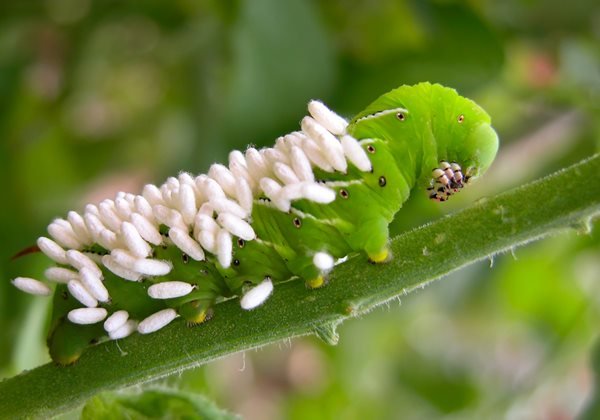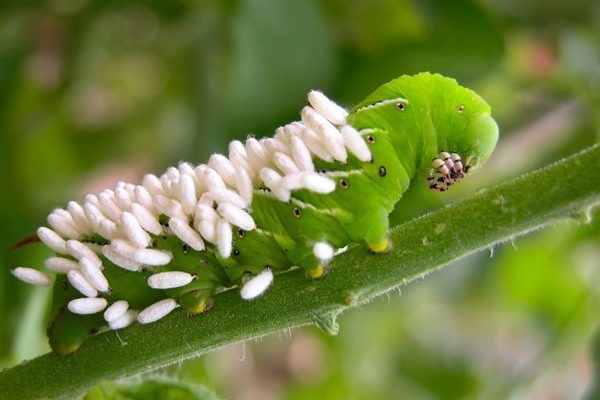
What Do Hornworm Eggs Look Like?
To successfully spot hornworm eggs, knowing their appearance is key. These eggs are small—about the size of a pinhead—and have a smooth, shiny surface. They often cluster together in groups of five to twenty, which makes them look like tiny, dewdrop-like specks on the underside of leaves. The color can vary, but they’re usually light to dark green or even yellow, blending in well with the plant foliage.
Here’s the thing: **hornworm eggs can be confused with other pests’ eggs** or simply with plant debris. This is why it’s important to observe them closely. You might want to grab a magnifying glass if you’re having trouble distinguishing them from the leaves or dirt.
When you’re out inspecting your plants, look on the underside of leaves, where these eggs are often laid. They like to lay eggs on host plants, such as tomatoes, peppers, and eggplants, so if you have these in your garden, pay extra attention.
Where to Find Hornworm Eggs
As I mentioned, hornworm eggs are typically found on the underside of leaves. These sneaky moths choose this spot because it offers a level of protection from predators and the elements. Just picture it: a cozy little nursery where the eggs have a better chance of hatching successfully.
When you’re scouting for these eggs, focus on the following areas:
- Garden favorites: Look closely at tomato plants, petunias, and other flowering plants. These are prime spots for hornworm eggs.
- Underside of leaves: Flip over the leaves gently. Most gardeners often overlook this area, which is where you’ll find those eggs hiding.
- Healthy plants: Healthy plants attract more pests. The healthier the plant, the more inviting it is for moths to lay their eggs.
By checking these areas consistently, you can catch hornworm eggs before they turn into ravenous caterpillars.
Signs of Egg Infestation
You might be wondering how to know if you have an infestation or just a few eggs. Identifying the signs early can help you manage the situation quickly. Here are some pointers:
1. **Clusters of eggs**: If you see groups of eggs, that’s a clear sign that moths have been active in your garden.
2. **White fuzzy caterpillars**: If you start spotting small, white caterpillars that blend into the leaves, they might be hornworms that have hatched from those eggs.
3. **Chewed leaves**: Look for holes or damage on the leaves. This is often a sign that the eggs have already hatched, and the caterpillars are hard at work.
If you notice any of these signs, it’s time to take action to prevent further damage to your plants.
How to Remove Hornworm Eggs
Once you’ve identified hornworm eggs, the next logical step is to remove them. Here’s how you can do it effectively:
Step 1: Inspect your plants regularly. Make it a routine to check your plants every few days. This helps you catch eggs before they hatch.
Step 2: Handpicking. Use your fingers or a small tool to gently scrape the eggs off the leaves. Be careful not to damage the plant. If you can, drop them into a container of soapy water to eliminate them effectively.
Step 3: Use natural predators. If you’re uncomfortable removing the eggs by hand, consider introducing beneficial insects like ladybugs or lacewings. They feed on caterpillars and can help stabilize the population naturally.
Taking these measures can significantly cut down on the hornworm population before they even get a chance to cause damage.
Preventing Future Hornworm Infestations
To keep your garden healthy and hornworm-free, prevention is key. Here are some effective strategies:
1. **Encourage natural predators**: As mentioned, ladybugs and lacewings are excellent for controlling hornworm numbers. Plant flowers that attract these insects to your garden.
2. **Use companion planting**: Consider planting marigolds or basil alongside your vegetables. These plants can repel harmful pests and attract beneficial insects.
3. **Keep your garden clean**: Regularly clean up debris and fallen leaves where pests might hide. A tidy garden is less inviting to moths looking for a place to lay eggs.
4. **Rotate crops**: Change the location of your plants every season. This disrupts the life cycle of pests, making it harder for them to find suitable host plants.
By implementing these practices, you can create an environment that’s less attractive to hornworms and other pests.
Identifying hornworm eggs on leaves is a crucial step in maintaining a healthy garden. By familiarizing yourself with their appearance, knowing where to find them, and taking action to remove them, you can protect your plants from these hungry caterpillars. Remember, staying vigilant and proactive will make a world of difference.
So, the next time you’re out in the garden, don’t forget to peek under those leaves. You might just save your plants from an unwanted feast! Happy gardening!

